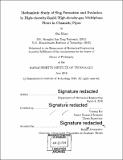Mechanistic study of slug formation and evolution in high-viscosity-liquid/High-density-gas multiphase flows in channels/pipes
Author(s)
Miao, Sha, Ph. D. Massachusetts Institute of Technology
DownloadFull printable version (19.13Mb)
Other Contributors
Massachusetts Institute of Technology. Department of Mechanical Engineering.
Advisor
Yuming Liu.
Terms of use
Metadata
Show full item recordAbstract
Rapidly rising global energy demand coupled with dwindling conventional oil resources has pushed unconventional oil, such as heavy oil, to become one of the most important future energy resources. However, design and operation of pipelines to transport heavy-oil/gas flows have raised new challenges associated with remarkably different flow regime transitions compared to conventional low-viscosity-oil/low-density-gas flows. Many traditional flow regime models for these oil/gas flows result in O(1) prediction errors when applied to high-viscosity-oil/high-density-gas flows because they fail to account for the complex change in physics and scales that occur as the fluid properties substantially change. Therefore, understanding the mechanisms that cause flow-regime transition for these types of flows is of critical importance to the development of physics-based models allowing for the creation of more robust and cost effective designs. The work described in this thesis focuses on investigating the fundamental mechanisms governing the initial growth and nonlinear evolution of interfacial waves leading to slugging in concurrent high-viscosity (laminar) liquid/high-density(turbulent) gas two-phase flows in horizontal channels/pipes. We first develop a Fully-Coupled Immersed Flow (FCIF) solver for the three-dimensional simulation of fluid-fluid interaction by coupling two distinct flow solvers using an Immersed Boundary (IB) method. The FCIF solver captures dynamic interactions between two fluids with disparate flow properties, while retaining the desirable simplicity of non-boundary-conforming grids. For the application of slug development with turbulent gas and laminar liquid, we couple an IB-based unsteady Reynolds Averaged Navier Stokes (uRANS) simulator with a depth-integrated (long-wave) solver in FCIF. We perform a series of validations on this method. The results demonstrate that the FCIF solver effectively captures the essential physics of gas-liquid interaction and can serve as a useful tool for the mechanistic study of slug generation in two-phase gas/liquid flows in channels and pipes.
Description
Thesis: Ph. D., Massachusetts Institute of Technology, Department of Mechanical Engineering, 2018. Cataloged from PDF version of thesis. Includes bibliographical references (pages 165-176).
Date issued
2018Department
Massachusetts Institute of Technology. Department of Mechanical EngineeringPublisher
Massachusetts Institute of Technology
Keywords
Mechanical Engineering.